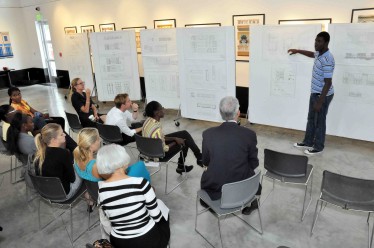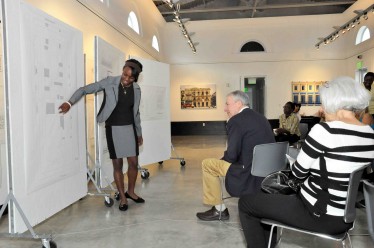A group of architecture students from UM and Haiti worked side by side this summer on a plan that would rebuild quake-ravaged Port-au-Prince block by block.

With School of Architecture Dean Elizabeth Plater-Zyberk (front row, left), faculty members Sam Roche, Rachel Valbrun, and Denis Hector; and UM and Haitian students looking on, Jean Denis Noel explains his architectural concept for redeveloping a two-block site in Port-au-Prince.
With pint-sized buildings made of strong yet lightweight cardboard, the scale model constructed by a group of architecture students shows existing structures on and proposed buildings for a two-block site in earthquake-ravaged Port-au-Prince, Haiti.
But if the series of design concepts created by the students ever take root, their vision to transform the two blocks so meticulously represented in the model will become a reality of government offices, shopping centers, and mixed-use buildings, giving the residents of Port-au-Prince a reinvigorated capital city.
During a collaborative urban design studio that focused on an urgent need to rebuild Haiti’s capital, eight architecture students from two universities in the Caribbean-island nation partnered this summer with four students from the University of Miami’s School of Architecture. Their goal was to redevelop central Port-au-Prince as an improved version of the city that existed before last year’s devastating 7.0-magnitude earthquake.
“It’s a plan to incrementally rebuild the city,” said UM School of Architecture Associate Dean Denis Hector, “and it’s achievable.”
Working at drafting tables several hours a day, the students converted their ideas into drawings, creating renderings of buildings that combine living quarters with retail space, sketching public parks where Haitian students would gather to do homework, and adding new architectural features such as arcades and galleries to existing structures.
Their designs for redeveloping two blocks of Port-au-Prince closely follow a plan proposed by the Miami-based architecture firm Duany Plater-Zyberk, which was commissioned by the Haitian government to develop a blueprint for central Port-au-Prince’s rebirth in collaboration with The Prince’s Foundation for the Built Environment, a charity organization backed by the Prince of Wales that supports sustainable building.

UM architecture student Jennifer Estime, whose parents were born in Haiti, presents her Port-au-Prince studio design: a residential complex with a courtyard and ground-floor shops.
In addition to new mixed-used development, the plan calls for consolidating public utilities for water, electricity, and sewage in the center of each city block, creating self-contained urban villages.
While putting the finishing touches on one of his designs on the last day of the studio, 27-year-old Wendy Jean-Charles, one of the eight Haitian students, shared his excitement over participating in the project, calling himself “lucky” to have had the chance to come to UM for five weeks, live on campus, and work side by side with UM students.
“This was a great opportunity to participate in something that could eventually be used to help rebuild my country,” said Jean-Charles, a Port-au-Prince resident who lost a cousin in the earthquake.
“This was not just another project for me,” explained UM student Jennifer Estime, sitting at a drafting table as she worked on her design, a residential complex with a courtyard and ground-floor shops. The daughter of Haitian parents, the U.S.-born Estime speaks fluent Creole, taught to her by her father because “he wanted me to have a connection to Haiti.” Her uncle died on the day of the temblor while working in a factory in Haiti, and several family members still live in the country. “That’s one of the reasons I signed up for this studio,” she said. “It could turn into a way to help get people back on their feet.”
But helping Haiti recover remains an uphill battle. More than a year and a half after the earthquake flattened Port-au-Prince, hundreds of thousands of victims still live in tents. Rebuilding efforts have progressed at a snail’s pace, with a cholera outbreak making matters worse.
Despite the slow rate of change in their country, the Haitian students who participated in the studio brimmed with hope and enthusiasm at the possibility of their designs becoming reality, agreed School of Architecture faculty members Sam Roche and Rachel Valbrun. The lead instructors of the project, Roche and Valbrun visited Haiti in late June to document the two-block site and meet with the eight Haitian students who would travel to Miami.
Supported by the UM President’s Office; American Airlines; the Consulate General of Haiti in Miami; Peter Bookholt, of Fort Lauderdale-based National Group; and David Tobin, of Hallandale Beach-based Harbour Construction, the studio began in mid-May. UM students launched the first half of the two-month-long project by analyzing Port-au-Prince’s existing urban layout, taking an inventory of the city’s distinctive architecture, and building the scale model. The design process got under way in earnest when the eight Haitian students arrived for the second half of the studio, with all of the students selecting individual sites and developing plans and elevations for new and renovated buildings.
Roche called their designs “well worked out” and “uniform” in quality, while Valbrun noted that the students, who brought different philosophies of architectural design to the studio, did an effective job of unifying their concepts and designing buildings that complemented one another.
The studio culminated with a jury presentation on August 3 at the Perez Architecture Center’s Korach Gallery. The students displayed and talked about their designs and drawings, which were critiqued by the architecture school’s Dean Elizabeth Plater-Zyberk, Associate Dean Hector, and lecturer Veruska Vasconez, as well as Henryka Manés, executive director of EcoWorks International, a Coral Gables-based nonprofit that works with disadvantaged communities to break their cycle of poverty. Bookholt, Tobin, and UM professor of architecture Jean-Francois LeJeune also attended the review.
The architectural concepts and drawings produced by the students will go into a booklet that will explain the studio’s major goals and strategies. The booklet will be presented to Duany Plater-Zyberk and the Prince’s Foundation as additional research for the firm’s plan for rebuilding Port-au-Prince.







